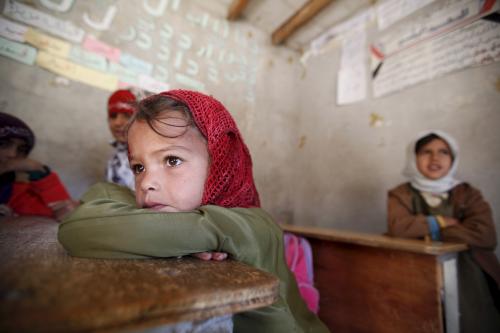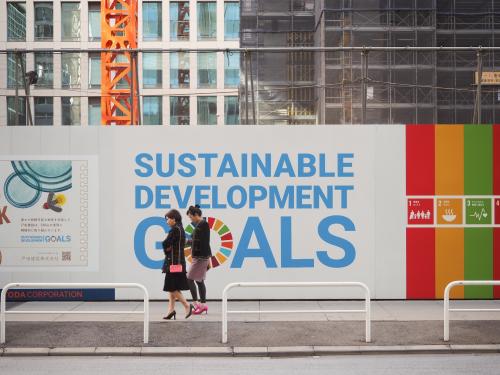Two years after the launch of the first development impact bond (DIB) for education, this innovative financing model is reporting promising results in both enrollment and learning gains. With one year remaining on the three-year contract, the program is already close to delivering the enrollment goals of out-of-school girls in Rajasthan, India. However, despite considerable progress in learning levels, they are only halfway to the final goal—highlighting the challenge and ambition of linking finance to results.
Social Challenge
Rajasthan, the province where the program is based, has education outcomes that are below national averages. Nationally, 3 percent of children between the ages of 6 and 13, and 3.2 percent of girls (about 3 million), are out of school. This increases to an estimated 8 percent of girls in Rajasthan. According to the 2016 Annual Status of Education Report (ASER), less than 24 percent of Standard III (Grade 3) children in Rajasthan could read at a Standard II level, slightly below the national average of 25 percent.
The intervention
The service provider, Educate Girls, identified out-of-school girls through door-to-door surveys, and has since worked to boost enrollment and attendance by engaging directly with households. Learning interventions focused around a child-centric curriculum are provided three times a week by volunteers to boys and girls in grades 3-5. The target group is 15,000 children, of which 9,000 are girls, in 166 public schools in the Bhilwara District. Instiglio, a non-profit impact bond and results-based financing intermediary organization, provided technical assistance to all organizations during the design of the DIB and currently provides performance management assistance to Educate Girls on behalf of UBS Optimus Foundation.
Why a DIB?
Each stakeholder had their own reasons for engaging with the impact bond. Educate Girls had the challenge of sustaining quality through the scale-up of their program, and was interested in participating in the DIB as a proof of concept of the mechanism. For the Children’s Investment Fund Foundation (CIFF), the outcome funder, the DIB offers the opportunity to tie payments to results, and therefore reduce the risk associated with non-performing grants. They were also interested in supporting the field of pay for performance models more generally. For the UBS Optimus Foundation, the investor, part of the appeal was the emphasis on the role of the private sector in bridging the funding gap to achieve the Sustainable Development Goals (SDGs).
Impact Metrics
The success of the impact bond will be judged against two metrics: enrollment (which makes up 20 percent of the outcome payment) and learning (80 percent of the outcome payment). The target for enrollment is 79 percent of the girls who were out of school at the baseline. Students’ learning is measured using the ASER test for English, Hindi, and Math, for which students receive a grade between A-E in each subject. The target for learning is a combined improvement of 5592 grade levels on this test, compared to a comparison group. IDinsight, a non-profit evaluation firm, will evaluate the improvement in learning of girls and boys in the program schools and will validate the number of out-of-school girls enrolled. CIFF has agreed to pay UBS Optimus Foundation $48.28 for each unit of improved learning and $935.64 for every percentage point increase in the enrollment of girls out of school.
Second Year Results
In July of last year, the Center for Universal Education at Brookings hosted a webinar, which explored the early results and learnings of the DIB. After the first year of the intervention, 44 percent of girls out of school at the baseline had been enrolled, and an increase in learning of 1537 grade levels had been achieved, equivalent to progress of 42 and 27 percent towards the overall target, respectively.
As Table 1 indicates, there has been continued improvement in year two, with the enrollment progress 88 percent of the target, with a year remaining of the intervention. Progress towards the learning target has nearly doubled, but it is only at 50 percent of the overall target, suggesting that it’s a more challenging metric to reach than enrollment.
Table 1: Comparing year-one and year-two results
| Metric | Target | Year-one results | Year-two results | |
| Enrollment | Out of School Girls that enroll in grades 2-8 — Out of School Girls at baseline |
79% | 44% (56% of target) | 69% (88% of target) |
| Learning | Grade levels of improvement on ASER test in Hindi, English and Math for boys and girls compared to comparison group | 5,592 grade levels | 1537 grade levels (27% of target) |
2,813 grade levels (50% of target) |
Key learnings between years one and two
- The flexibility of a DIB has been valuable
Structuring the payments around outcomes enabled the service provider to respond to the needs of the program recipients, adapting the program to target those hardest to reach, and redesigning the curriculum in response to analysis of learning data. Children who spent the longest in the program have reaped the most rewards: 84 percent of the learning gains were experienced by children who received the full two years of the program.
- Taking a step back can be challenging for outcome payers
Outcome payers with existing expertise in the area may struggle with a hands-off approach to service delivery. The impact bond structure requires outcome payers to grant service providers the independence to innovate and experiment, which may necessitate a shift in culture inside these organizations.
- Contracts should have structures for responding to unforeseen changes
Including pre-agreed rules for handling unforeseen changes between different stakeholders can help all the parties navigate challenges throughout the contract. Between the first and second year, the real numbers of out-of-school girls were found to be lower than estimated in the baseline. In response to this, the price-per-learning outcome was adjusted with the agreement of the investor and outcome payer.
Conclusion
The second-year results of the Educate Girls DIB indicate exciting progress for the program, as well as a variety of interesting lessons for the impact bond model. Progress in enrollment and learning outcomes has been considerable—particularly for the hardest to reach—and those who have stayed in the program over the full duration. Practitioners in the process of designing their own impact bonds will benefit greatly from the learnings of this early model, particularly in the design of effective contracts, and in framing the relationships between the stakeholders.
The Brookings Institution is committed to quality, independence, and impact.
We are supported by a diverse array of funders. In line with our values and policies, each Brookings publication represents the sole views of its author(s).

![Photo: The colors of the Colombian flag are reflected in a canal next to the convention center in Cartagena, Colombia. [Reuters/Jaime Saldarriaga]](https://www.brookings.edu/wp-content/uploads/2017/03/colombia_flag002.jpg?quality=75&w=500)



Commentary
Two years in: How’s the world’s first development impact bond for education doing?
July 13, 2017